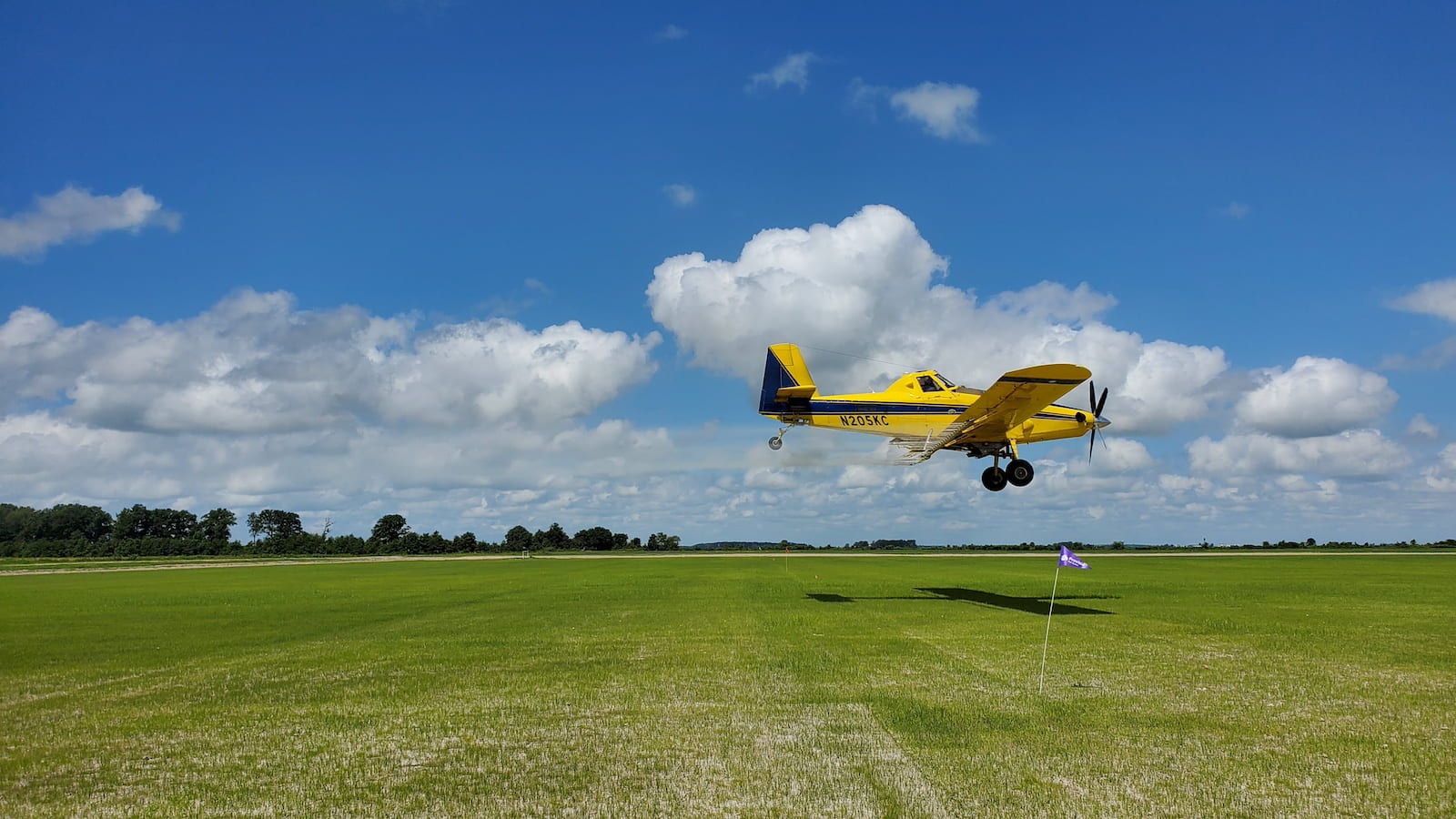Herbicide Drift Study Provides New Recommendations for Aerial Applications

Soybeans offer a potential late-season food source for pollinators but are sensitive to damage from herbicide drift, or when an herbicide moves away from its intended target. Researchers with the Arkansas Agricultural Experiment Station conducted a study to determine the effects of spray drift from ground and air-based applications. The study validated U.S. Environmental Protection Agency herbicide drift prediction models and provides recommendations for aerial applications of Loyant®. The researchers estimate that implementation of the mitigation strategies recommended by this research could save nearly $2 million each year for Arkansas growers and applicators.
The Problem
Herbicide “drift” occurs when the wind carries an herbicide application off target and causes unintended damage to a nearby crop. In Arkansas alone, an average of 400 drift complaints have been filed with the Arkansas State Plant Board each year since 2018. The herbicide Loyant®, which is commonly used on rice fields to control barnyardgrass, sedges and pigweed, can cause harm to neighboring soybean crops. When soybean plants are damaged by herbicide drift, the negative effects go beyond the plants themselves. Although self-pollinating, soybean plants offer a pollinator foraging source late in the season.
The Work
A study on ground and air applications of the herbicide Loyant® was conducted at the Rice Research and Extension Center in Stuttgart by Tommy Butts, researcher with the Arkansas Agricultural Experiment Station and extension weed scientist with the Arkansas Cooperative Extension Service. For the ground-based applications, researchers used a Case 5550 AimPoint tractor with a 100-foot boom, set 3 feet above the ground, driving 20 mph across the test area. For aerial applications, they used an AirTractor 802A with a 72-foot swath width. The plane flew an average of 15 feet above the ground with an average airspeed of 145 mph.
Researchers conducted 10 spray passes with both application methods while in an average 8 mph crosswind. The impacts of herbicide drift were measured using water-sensitive cards and by evaluating the effects on soybean reproductive structures.
The Results
Results from the research indicated that aerial applications had an increase in downwind spray drift of about three- to five-fold compared to the ground application across all data collected. Researchers found that soybean reproductive structures were reduced by 25 percent up to 100 feet downwind from a ground-based application. Drift from aerial applications damaged nearly 100 percent of soybean reproductive structures at 200 feet downwind.
Based on their research, Butts and co-authors of the study recommend that aerial applicators use a “coarse” droplet size and make three to five complete upwind swath width adjustments to reduce spray drift potential.
Drift mitigation recommendations for both application methods also include drift reduction adjuvants, reduced boom and flight heights and applying when the wind direction is more favorable, blowing away from sensitive areas.
The Value
Butts said a better understanding of application drift potential and implementation of the mitigation strategies recommended by this research could save nearly $2 million each year for Arkansas growers and applicators. He estimates a corresponding potential for reducing drift complaints by 50 percent.
Additionally, decreased herbicide drift and damage to soybeans would provide more potential foraging sources for pollinators, which provide critical services to the environment and agriculture.
Read the Research
Herbicide spray drift from ground and aerial applications: Implications for potential pollinator foraging sources
Scientific Reports
Volume 12, 18017 (2022)
doi.org/10.1038/s41598-022-22916-4
Supported in part by
USDA-ARS Award Nos. 58-6066-9-047 and 58-3091-1-015, checkoff funds distributed by the Arkansas Soybean Promotion Board. Additional assistance provided by Tri-County Farmers Associates and Cole Hartley of Hartley Flying Service.
About the Researcher
Read the Research
Herbicide spray drift from ground and aerial applications: Implications for potential pollinator foraging sources
Scientific Reports
Volume 12, 18017 (2022)
doi.org/10.1038/s41598-022-22916-4
Supported in part by
USDA-ARS Award Nos. 58-6066-9-047 and 58-3091-1-015, checkoff funds distributed by the Arkansas Soybean Promotion Board. Additional assistance provided by Tri-County Farmers Associates and Cole Hartley of Hartley Flying Service.

Thomas Butts
Associate Professor and Extension Weed Scientist
Ph.D. Agronomy-Weed Science, University of Nebraska-Lincoln
M.S., Agronomy-Weed Science, University of Wisconsin-Madison
B.S., Agricultural Business, University of Wisconsin-Platteville
